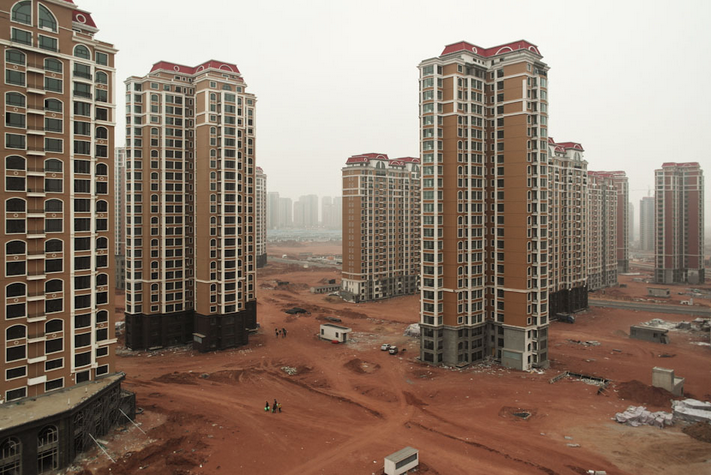
In this article, originally published in Metropolis Magazine's Point of View blog as "The Real Problem with China's Ghost Towns" , author Peter Calthorpe explains the problems of these cities, predicts their grim future, and explores how the thoughtful planning behind the city of Chenggong could provide a more sustainable alternative.
We’ve all seen the reports on “ghost town” developments in China, showing acres of empty high-rise apartments and vacant shopping malls. These barren towns seem particularly ironic in a country planning to move 250 million people from the countryside to cities in the next 20 years. But this massive, unprecedented demand has been distorted by a number of factors unique to China. Flawed financial incentives for cities and developers, along with the poor phasing of services, amenities, and jobs create most of the problems. In addition, China’s emerging middle class is very comfortable (perhaps too comfortable) investing in real estate, so people often buy apartments in incomplete communities but don't move in, expecting that values will rise, or that they will live there someday. The result is a string of large, empty developments that remain speculative investments rather than real homes and communities. [See-through buildings are the worry now, but the real problems may come when they are full.]
While it’s hard to get data on vacancy levels in China, there are certainly many anecdotal examples across the country. An all-too-typical example is Chenggong, the new town planned for 1.5 million just outside of Kunming in the west. This freshly minted city boasts the growing Yunnan University, currently with 170,000 students and faculty; a new government center; and an emerging light industrial area. Under construction are the city’s new high-speed rail station and two metro lines connecting the historic city center.

The town has been growing at a robust 6% a year. There seems to be lots of activity to prime the pump, but even here there are scores of vacant buildings. Why? Foremost is Chinese tax policy: there are no local property taxes so cities derive most of their income from developing land. The incentive is to lease large tracts of land (land sales are illegal in China), even if the market and complementary services aren’t ready. Without an ongoing property tax, the long-term viability of the towns is a secondary consideration. Compounding this, the average Chinese worker, with their high savings rate, needs investment options. Lacking a transparent stock market, most workers prefer to own real estate if they can, both as an investment and as future home for a child. They often buy with cash, and with no debt and no property tax it’s easy to hold empty apartments. Additionally, the country has yet to see a drop in real estate values so the properties seem safe. (Sound familiar?)
In addition to these buy-now financial incentives, the transit in Chenggong isn’t complete, and many of the town’s services and schools are yet to come. Consequently, many people purchase apartments but stay in their old homes until the new community is complete or their child marries. The good news here: these tax, investment, and development policies can be easily corrected, and in fact the central government is considering new property taxes, limits to second home speculation, and a more strategic phasing of infrastructure.
Perhaps more significant than these market irregularities and flawed policies is the long-term viability and health of the new towns. Most development in China takes the form of superblocks with towers in the park-style gated communities. At up to a quarter of a mile to an intersection and often eight lanes of automobile traffic across the street, walking and biking in these districts is difficult and dangerous. Driving then skyrockets worsening congestion, air pollution, carbon emissions, and household costs. In Jinan, a study showed a quadrupling of auto travel in the newer superblock developments.
In addition to these growing economic and environmental issues, these developments—some containing more than 5,000 dwellings—hold the seeds of rapid social decay. As we experienced in the West, this urban pattern isolates people in huge impersonal landscapes that lack identity, safety (no “eyes on the street”), community, and a human scale. We demolished a generation of social housing built on this model, and I believe the Chinese eventually will too.

Fortunately, Chenggong is experimenting with a new model of urban planning. With support from the national government and planning by the China Sustainable Transportation Center, our firm is redesigning 2,500 acres in the central district of the new town. The superblocks have been broken down to human-scale, traditional courtyard blocks. The streets are smaller and more frequent—and many are auto free or dedicated for transit. Parks are smaller but closer and safer with housing overlooking each. Mixed-use buildings with sidewalk oriented shops and cafes rebuild the street-life that was once a hallmark of older Chinese communities. And ultimately jobs will balance with housing, avoiding the “bedroom community” disease that eroded suburbs all over the world.

This new pattern is in its “pilot” phase with government officials studying the results and policy implications. But there is every reason to believe timely corrections can be made, both in the incentives that distort the market and, perhaps most important, in China’s new cities. Creating the appropriate design DNA as well as the proper economic incentives will profoundly impact the long-term social, economic and environmental viability of urban centers that will be the largest and fastest growing in the history of mankind. For all of our sakes, let’s hope China gets it right.
Peter Calthorpe, a Berkeley-based architect and planner, heads up Calthorpe Associates. He is a founding member of the Congress for the New Urbanism and the author of several books, including his latest, Urbanism in the Age of Climate Change.
Featured Image by Tim Franco. Visit his site at timfranco.com.

